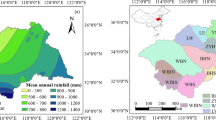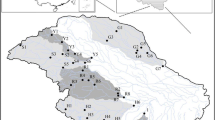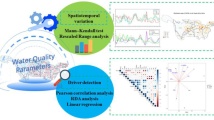Abstract
Our study analyzed the spatio-temporal trends of four major water quality parameters (i.e., dissolved oxygen (DO), ammonium nitrogen (NH3-N), total phosphorus (TP) and permanganate index (CODMn)) at 17 monitoring stations in one of the most polluted large river basins, Huai River Basin, in China during 2005 to 2014. More concerns were emphasized on the attributions, e.g., anthropogenic actives (land cover, pollution load, water temperature, and regulated flow) and natural factors (topography) to the changes in the water quality. The seasonal Mann–Kendall test indicated that water quality conditions were significantly improved during the study period. The results given by the Moran’s I methods demonstrated that NH3-N and CODMn existed a weak and moderate positive spatial autocorrelation. Two cluster centers of significant high concentrations can be detected for DO and TP at the Mengcheng and Huaidian station, respectively, while four cluster centers of significant low concentrations for DO at Wangjiaba and Huaidian station in the 2010s. Multiple linear regression analysis suggested that water temperature, regulated flow, and load of water quality could significantly influence the water quality variations. Additionally, urban land cover was the primary predictor for NH3-N and CODMn at large scale. The predictive ability of regression models for NH3-N and CODMn declined as the scale decreases or the period ranges from the 2000s to the 2010s. Topography variables of elevation and slope, which can be treated as the important explanatory variables, exhibited positive and negative correlations to NH3-N and CODMn, respectively. This research can help us identify the water quality variations from the scale-process interactions and provide a scientific basis for comprehensive water quality management and decision making in the Huai River Basin and also other river basins over the world.





Similar content being viewed by others
References
Ahearna DS, Sheibley RW, Dahlgrena RA (2005) Land use and land cover influence on water quality in the last free-flowing river draining the western Sierra Nevada, California. J Hydrol 313(3–4):234–247
Amini H, Haghighat GA, Yunesian M, et al. (2016) Spatial and temporal variability of fluoride concentrations in groundwater resources of Larestan and Gerash regions in Iran from 2003 to 2010. Environ Geochem Health 38(1):25–37
Amuchástegui G, di Franco L, Feijoó C (2016) Catchment morphometric characteristics, land use and water chemistry in Pampean streams: a regional approach. Hydrobiologia 767(1):65–79
Anselin L (1995) Local indicators of spatial association—LISA. Geogr Anal 27(2):93–115
Anselin L (1996) The Moran scatterplot as an ESDA tool to assess local instability in spatial association. In: Fisher M, Scholten H, Unwin D (eds) Spatial analytical perspectives on GIS in environmental and socio-economic sciences. Taylor and Francis, London, pp. 111–125
Antonopoulos VZ, Papamichail DM, Mitsiou KA (2001) Statistical and trend analysis of water quality and quantity data for the Strymon River in Greece. Hydrol Earth Syst Sci 5(4):679–692
Asterious D, Hall SG (2011) Applied econometrics, 2nd edn. Palgrave Macmillan p 95–108
Boeder M, Chang H (2008) Multi-scale analysis of oxygen demand trends in an urbanizing Oregon watershed, USA. J Environ Manag 87(4):567–581
Bouza-Deaño R, Ternero-Rodríguez M, Fernández-Espinosa AJ (2008) Trend study and assessment of surface water quality in the Ebro River (Spain). J Hydrol 361(3–4):227–239
Brody SD, Highfield W, Peck BM (2005) Exploring the mosaic of perceptions for water quality across watersheds in San Antonio, Texas. Landsc Urban Plan 73(2):200–214
Buck O, Niyogi DK, Townsend CR (2004) Scale-dependence of land use effects on water quality of streams in agricultural catchments. Environ Pollut 130(2):287–299
Buendia C, Bussi G, Tuset J, Vericat D, Sabater S, Palau A, Batalla RJ (2016) Effects of afforestation on runoff and sediment load in an upland Mediterranean catchment. Sci Total Environ 540:144–157
Chang H (2008) Spatial analysis of water quality trends in the Han River basin, South Korea. Water Resour 42(13):3285–3304
Chang H, Carlson T (2005) Water quality during winter storm events in Spring Creek, Pennsylvania, USA. Hydrobiologia 544(1):321–332
Chen Y, Takeuchi K, Xu C, et al. (2006) Regional climate change and its effects on river runoff in the Tarim Basin, China. Hydrol Process 20(10):2207–2216
China Environment Bulletin (2014) Ministry of Environmental Protection of the People’s Republic of China [in Chinese]
Dale MR, Fortin MJ (2014) Spatial analysis: a guide for ecologists. Cambridge University Press
Djodjic F, Bergström L (2005) Phosphorus losses from arable fields in Sweden—effects of field-specific factors and longterm trends. Environ Monit Assess 102(1–3):103–117
Dormann CF, McPherson JM, Araújo MB, et al. (2007) Methods to account for spatial autocorrelation in the analysis of species distributional data: a review. Ecography 30(5):609–628
Dou M, Zheng BQ, Zuo QT, Qi M (2013) Identification of quantitative relation of ammonia-nitrogen concentration and main influence factors in the river reaches controlled by sluice. J Hydraul Eng 44(8):934–941 [in Chinese]
Dou M, Zhang Y, Zuo QT, Mi QB (2015) Identification of key factors affecting the water pollutant concentration in the sluice-controlled river reaches of the Shaying River in China via statistical analysis methods. Environ Sci: Proc Impact 17(8):1492–1502
ESRI (2013) ArcGIS desktop: release 10.2.1. Environmental Systems Research Institute, Redlands, CA
GB 11892–1989 (1989) The state environmental protection standards of the People’s Republic of China: water quality determination of permanganate index [in Chinese]
GB 11893–1989 (1989) The state environmental protection standards of the People’s Republic of China: water quality determination of total phosphorus [in Chinese]
Haidary A, Amiri BJ, Adamowski J, Fohrer N, Nakane K (2013) Assessing the impacts of four land use types on the water quality of wetlands in Japan. Water Resour Manag 27(7):2217–2229
Helsel DR, Hirsch RM (1992) Statistical methods in water resources. Elsevier, Amsterdam
Hirsch RM, Slack JR (1984) A nonparametric trend test for seasonal data with serial dependence. Water Resour Res 20(6):727–732
Hirsch RM, Slack JR, Smith RA (1982) Techniques of trend analysis for monthly water quality data. Water Resour Res 18(1):107–121
Hirsch RM, Alexander RB, Smith RA (1991) Selection of methods for the detection and estimation of trends in water quality. Water Resour Res 27(5):803–813
HJ 506–2009 (2009) The state environmental protection standards of the People’s Republic of China: water quality-determination of dissolved oxygen—electrochemical probe method [in Chinese]
HJ 535–2009 (2009) The state environmental protection standards of the People’s Republic of China: water quality determination of ammonia nitrogen—Nessler’s reagent spectrophotometry [in Chinese]
Huang D, He XL, Yang G, Wang CX, Du YJ, Yang WX, Xu SD (2012) Temporal and spatial analysis of surface water quality in Manas River basin. J Shihezi Univ (Natural Science) 30(6):749–754 [in Chinese]
Joarder MAM, Raihan F, Alam JB, Hasanuzzaman S (2008) Regression analysis of ground water quality data of Sunamganj District, Bangladesh. Int J Environ Res 2(3):291–296
Jones KB, Neale AC, Nash MS (2001) Predicting nutrient and sediment loadings to streams from landscape metrics: a multiple watershed study from the United States mid-Atlantic region. Landsc Ecol 16(4):301–312
Lettenmaier DP, Hooper ER, Wagoner C, Faris KB (1991) Trends in stream quality in the continental United States, 1978–1987. Water Resour Res 27(3):327–339
Li S, Gu S, Tan X, Zhang Q (2009) Water quality in the upper Han River basin, China: the impacts of land use/land cover in riparian buffer zone. J Hazard Mater 165(1):317–324
Li S, Xia X, Tan X, Zhang Q (2013) Effects of catchment and riparian landscape setting on water chemistry and seasonal evolution of water quality in the upper Han River basin, China. PLoS One 8(1):e53163
Liu C, Xia J (2004) Water problems and hydrological research in the Yellow River and the Huai and Hai River basins of China. Hydrol Process 18(12):2197–2210
Ma F, Ye A, Gong W, Mao Y, Miao C, Di Z (2014) An estimate of human and natural contributions to flood changes of the Huai River. Glob Planet Chang 119:39–50
Moran PAP (1950) Notes on continuous stochastic phenomena. Biometrika 37(1–2):17–23
Mueller DK, Ruddy BC, Battaglin WA (1997) Logistic model of nitrate in streams of the upper-midwestern United States. J Environ Qual 26(5):1223–1230
Nash MS, Heggem DT, Ebert D, Wade TG, Hall RK (2009) Multi-scale landscape factors influencing stream water quality in the state of Oregon. Environ Monit Assess 156(1–4):343–360
O’Sullivan D, Unwin DJ (2003) Geographic information analysis. Wiley, Hoboken, NJ
Plummer JD, Long SC (2007) Monitoring source water for microbial contamination: evaluation of water quality measures. Water Res 41(16):3716–3728
Pratt B, Chang H (2012) Effects of land cover, topography, and built structure on seasonal water quality at multiple spatial scales. J Hazard Mater 209(4):48–58
Richards C, Johnson LB, Host GE (1996) Landscape-scale influences on stream habitats and biota. Can J Fish Aquat Sci 53(53):295–311
Robson AJ, Neal C (1996) Water quality trends at an upland site in Wales, UK, 1983–1993. Hydrol Process 10(2):183–203
Simeonov V, Stratis JA, Samara C, et al. (2003) Assessment of the surface water quality in northern Greece. Water Res 37(17):4119–4124
Sliva L, Williams DD (2001) Buffer zone versus whole catchment approaches to studying land use impact on river water quality. Water Res 35(14):3462–3472
Sokal RR, Oden NL (1978a) Spatial autocorrelation in biology: I. Methodology. Biol J Linn Soc 10(2):199–228
Sokal RR, Oden NL (1978b) Spatial autocorrelation in biology: II. Some biological implications and four applications of evolutionary and ecological interest. Biol J Linn Soc 10(2):229–249
Sonoda K, Yeakley JA, Walker CE (2001) Near-stream land use effects on stream water nutrient distribution in an urbanizing watershed. J Am Water Resour Assoc 37(6):1517–1532
Steele TD, Jennings ME (1972) Regional analysis of streamflow chemical quality in Texas. Water Resour Res 8(2):460–477
Tobler WR (1970) A computer movie simulating urban growth in the Detroit region. Econ Geogr 46(2):234–240
Velleman PF, Roy EW (1981) Efficient computing of regression diagnostics. Am Stat 35(4):234–242
Wan R, Cai S, Li H, Yang G, Li Z, Nie X (2014) Inferring land use and land cover impact on stream water quality using a Bayesian hierarchical modeling approach in the Xitiaoxi River watershed, China. J Environ Manag 133:1–11
Wherry RJ (1931) A new formula for predicting the shrinking of the coefficient of multiple correlation. Ann Math Stat 2(4):440–457
Yan B, Fang NF, Zhang PC, Shi ZH (2013) Impacts of land use change on watershed streamflow and sediment yield: an assessment using hydrologic modelling and partial least squares regression. J Hydrol 484(6):26–37
Yu D, Shi P, Liu Y, Xun B (2013) Detecting land use-water quality relationships from the viewpoint of ecological restoration in an urban area. Ecol Eng 53(3):205–216
Zhai X, Xia J, Zhang Y (2014) Water quality variation in the highly disturbed Huai River basin, China from 1994 to 2005 by multi-statistical analyses. Sci Total Environ 496:594–606
Zhang Y, Xia J, Shao Q, Zhai X (2013) Water quantity and quality simulation by improved SWAT in highly regulated Huai River basin of China. Stoch Env Res Risk A 27(1):11–27
Zhao CS, Sun CL, Xia J, Hao XP, Li FG, Rebensburg K, Liu CM (2010) An impact assessment method of dam/sluice on instream ecosystem and its application to the Bengbu sluice of China. Water Resour Manag 24(15):4551–4565
Zhao J, Lin L, Yang K, Liu Q, Qian G (2015) Influences of land use on water quality in a reticular river network area: a case study in shanghai, China. Landsc Urban Plan 137:20–29
Zipper CE, Holtzman GI, Darken PF, Gildea JJ, Stewart RE (2002) Virginia USA water quality, 1978 to 1995: regional interpretation. J Am Water Resour Assoc 38(3):789–802
Zuo Q, Chen H, Dou M, Zhang Y, Li D (2015) Experimental analysis of the impact of sluice regulation on water quality in the highly polluted Huai River basin, China. Environ Monit Assess 187(7):1–15
Acknowledgments
This research was supported by the National Grand Science and Technology Special Project of Water Pollution Control and Improvement (no. 2014ZX07204-006). Thanks also to the editors and one anonymous reviewer for their constructive comments on the earlier draft, which led to a great improvement of the final paper.
Author information
Authors and Affiliations
Corresponding authors
Additional information
Responsible editor: Kenneth Mei Yee Leung
Rights and permissions
About this article
Cite this article
Shi, W., Xia, J. & Zhang, X. Influences of anthropogenic activities and topography on water quality in the highly regulated Huai River basin, China. Environ Sci Pollut Res 23, 21460–21474 (2016). https://doi.org/10.1007/s11356-016-7368-8
Received:
Accepted:
Published:
Issue Date:
DOI: https://doi.org/10.1007/s11356-016-7368-8




